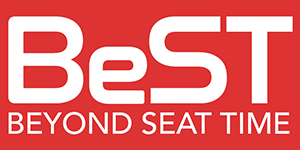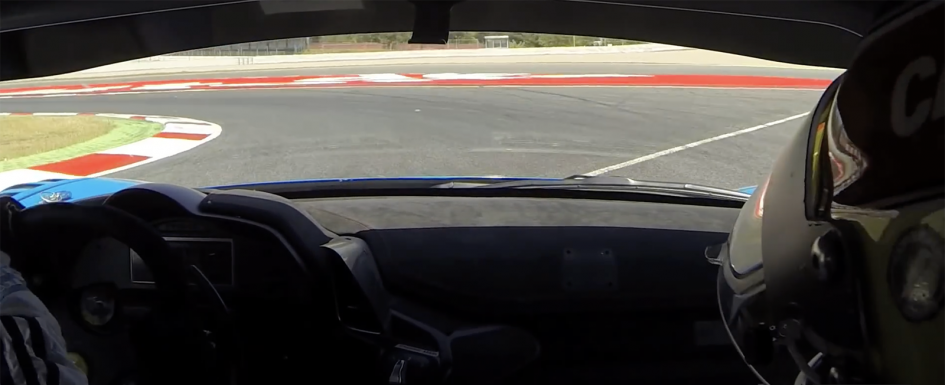There are 3 reasons we need to look ahead… that all build on one another.
1st, we need to look ahead to give our brains the visual information it needs to draw smooth arcs from where we are to where we need to go. If we don’t look ahead, we are stuck relying purely on memory to get us around the track. The problem this creates is that unless our memory is perfect, we become susceptible to driving point to point, or in the case of autocross, from cone to cone. We end up poorly positioned, and are unable carry as much speed as we could through the track. Additionally, when driving down the highway, have you ever noticed how looking at the road stripes way ahead makes them look to be moving slower than if you look at the stripes as they go by the car? The same principle applies on track. Looking ahead slows things down, and gives us more time to plan and react.
2nd, and taking it one step further, looking ahead gives us the visual information needed for us to see the direction in which we need to direct the forces of the car. We discuss this in great detail in The Complete Autocrosser’s Manual (and will be discussed deeply in the upcoming course: The Complete Track Driver’s Manual). Our intuition rightfully wants to aim the forces of the car in the most efficient direction. When we don’t look ahead effectively, we may drive around a corner satisfied in the feeling that we are driving on the limit of grip. But that alone is not enough. When we use our eyes to see where we should be directing the forces of the car, we are immediately able to tell whether or not we are traveling on the most efficient path around the corner. Using our vision is an essential part of seeing the ideal line that we should be on.
3rd, looking ahead plays a crucial role in helping us evaluate our driving! This is not something that is often talked about. We know that looking ahead gives us the information needed to see and process the course early and helps us know where to direct the forces of the car. But we can also use looking ahead to evaluate our performance, because our visual cues are one of the most important cues we have at our disposal to tell how efficiently we are moving through the course. Auditory cues (sound) can only roughly tell us if we are at the limit; they cannot tell us if we are on the right path. The feeling of g-forces can tell us when we are feeling the maximum amount of force, but by themselves, they cannot tell us if those forces are pointed in the optimal direction. Using our vision by looking ahead is indispensable because it is the best cue we have for being able to evaluate how effectively we are utilizing the forces from the car.
“OK”, you may say, “That’s all well and good. But how do I get better at this? Where should I be looking? How far ahead? And what should I do with the information?”
1. Where to look? How far ahead?
You could ask different people and you will likely get different answers, but generally speaking, I believe it is most useful to look at least 2 points of interest ahead of where we are. A “point of interest” is anywhere on the track where we make a significant change in our inputs, or a limiting point on the track, such as… the braking point, the turn in point, the apex, the track out point, and so on. As an example, imagine we are on a straightaway headed towards a corner. Instead of intently staring at the braking point (which is the next immediate point of interest), our vision should be towards the turn in point and the apex. Once we begin braking, we should no longer be staring at the turn in point; rather our heads should be turned and paying attention through the apex and the corner exit/track out point. And so on.
You may be wondering why I suggest “2 points of interest ahead of where we are”. It is simply a function of how our brains work. The brain tries to direct us as efficiently as possible from where we are, to where we are looking. If we stare directly at the upcoming point of interest, say the turn in point, we may nail the turn in, but we gave our brain no information at all about where the apex is! So when we then look for the apex after turning in, it is already too late. If we look 1 point of interest ahead of where we are, the brain has the information needed to move efficiently to that point, say from the turn in to the apex. But that results in us driving directly towards the apex, and we are poorly positioned to make a smooth arc around the corner (i.e. we drive point to point). It is only when we look at least 2 points of interest ahead that we give ourselves enough information to SEE an arc from the point where we are (turn in), through the first point ahead (apex), to the second point ahead (track out). Looking 2 points of interest ahead allows us to make an arc through the first point at an optimal angle.
2. What to do with the information?
It is very common for drivers to spend some time trying to learn to look ahead, but then give up on it because it didn’t really make them faster. Perhaps you’ve experienced this too? The issue is that no one really tells us HOW to look ahead, and what to do with the resulting visual information. No one tells us how we can ensure that we still hit our braking point dead on, or nail our apex, while looking ahead. So we end up trying to look ahead, but start missing our marks, get discouraged, and go back to doing what we’ve always done.
The first thing for us to consider is that looking ahead does not mean staring ahead. The idea is to glance/scan back and forth. Remember, the aim is to give our brain the visual information it needs in order to make mental arcs from where we are to where we are trying to go. This glancing back and forth is hard/unnatural, and takes some conscious practice. Just forcing yourself to look ahead will not work, and this is where most drivers struggle. As we are working on this skill, at first, we may choose to give equal weight to glancing ahead and glancing closer. That’s ok; keep at it. Over time, as we develop the habit of moving our eyes, it will become easier for us to keep MORE of our focus ahead of where we are, and begin relying on our peripheral vision to pick up on the things that are closer to us.
This is a VITAL thing to keep in mind. We are naturally wired to focus our vision on whatever we think needs our attention. By practicing glancing ahead, we are training ourselves to not rely only on the center of our vision, but to also pick up spatial information from the periphery. The better we get at being able to rely on our peripheral vision for the stuff that is closer to us, the broader our range of focus becomes, and the more we will be able to keep our vision and attention ahead.
3. How does it help drive faster?
Key Idea: Looking ahead helps us utilize the space we have efficiently, in order to point the forces of our car in the appropriate direction.One of the most common problems on a track or autocross course is for drivers to make corners tighter than they are by driving point to point; by not making efficient use of the space that is available. In most cases, it is not that the driver is trying to make the corner tight; it is just what happens when we don’t look ahead. Looking ahead more effectively helps these drivers see that they can open up the corners more in order to carry much more speed around the track. Drivers are often blown away by how different (and how much more open) a corner looks when they learn to look ahead well.
That said, for many drivers, the opposite is true! Many drivers have been taught to aim for a late apex in corners in order to carry more speed onto the subsequent straightaway. These drivers often drive deep into a corner, get the car turned, and feel good about being able to get on the gas before the apex. When these drivers learn to look ahead effectively, it almost immediately changes their lines! They are able to see how their chosen line is hurting their lap times by making the entry deeper and slower than it needs to be. They previously may have felt like they were getting the most out of their car because the hard/deep braking and the early throttle made the g-forces feel high. But when they start using their vision to see where those forces are being directed, they immediately become aware that they are on a sub-optimal line.
Said more simply: Looking ahead helps us drive faster by giving us the visual information to use all the space on the track that we need…
but not an inch more.


I was waiting for your paragraph on “thinking ahead”.
That’s funny 🙂 When I drafted the post, I had a big paragraph about “thinking ahead”, but then edited it out because the post was too long, and there were other ideas that I felt were important to communicate.
But you are absolutely right, looking ahead plays an integral role in forcing us to think ahead of where we are.
I like the “2 points of interest ahead” way of looking at it, but talk about how to stay 2 points ahead. I find my self starting well, but often find my vision drawing up in a combination of movements, where I start ahead but fall behind. How do you “waltz” the vision two steps forward and one back to handle what’s in front while continuing to move your vision ahead?
What you described is precisely the challenge; it is difficult to build the discipline to KEEP our vision moving ahead. In my experience, the greatest difficulty is on corner entry. When we are on the straight approaching a corner, at first we may be good about looking ahead to the apex. But as we get closer to the braking point, our vision drops and we fixate on the braking point, and then we fixate on the turn in point, and then we fixate on the apex… all the while breaking our focus from looking 2 points ahead. I wish there was some magic bullet easy answer to give here, but the truth is, building this habit is just like building any other habit… it is a function of being deliberate about changing behavior until it feels natural. The moment you become aware that you are not looking ahead anymore, start doing it again!